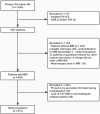Cortical superficial siderosis, hematoma volume, and outcomes after intracerebral hemorrhage: a mediation analysis
- PMID: 37213900
- PMCID: PMC10196120
- DOI: 10.3389/fneur.2023.1122744
Cortical superficial siderosis, hematoma volume, and outcomes after intracerebral hemorrhage: a mediation analysis
Abstract
Background: Previous studies have shown that cortical superficial siderosis (cSS) can increase hematoma volume and predict poor outcomes following primary intracerebral hemorrhage (ICH).
Objective: We aimed to determine whether a large hematoma volume was the essential factor contributing to worse outcomes of cSS.
Methods: Patients with spontaneous ICH underwent a CT scan within 48 h after ictus. Evaluation of cSS was performed using magnetic resonance imaging (MRI) within 7 days. The 90-day outcome was assessed using the modified Rankin Scale (mRS). In addition, we investigated the correlation between cSS, hematoma volume, and 90-day outcomes using multivariate regression and mediation analyses.
Results: Among the 673 patients with ICH [mean (SD) age, 61 (13) years; 237 female subjects (35.2%); median (IQR) hematoma volume, 9.0 (3.0-17.6) ml], 131 (19.5%) had cSS. There was an association between cSS and larger hematoma volume (β = 4.449, 95% CI 1.890-7.009, p < 0.001) independent of hematoma location and was also related to worse 90-day mRS (β = 0.333, 95% CI 0.008-0.659, p = 0.045) in multivariable regression. In addition, mediation analyses revealed that hematoma volume was an essential factor mediating the effect of cSS on unfavorable 90-day outcomes (proportion mediated:66.04%, p = 0.01).
Conclusion: Large hematoma volume was the major charge of directing cSS to worse outcomes in patients with mild to moderate ICH, and cSS was related to a larger hematoma in both lobar and non-lobar areas.
Clinical trial registration: https://clinicaltrials.gov/ct2/show/NCT04803292, identifier: NCT04803292.
Keywords: ICH volume and outcome; cSS; cerebral hemorrhage; hematoma; mediation analysis; prospective studies.
Copyright © 2023 Jin, Li, Wu, Huang, Yang, An, Yuan, Gao and Tong.
Conflict of interest statement
The authors declare that the research was conducted in the absence of any commercial or financial relationships that could be construed as a potential conflict of interest.
Figures


Similar articles
-
Combined effect of cortical superficial siderosis and cerebral microbleed on short-term and long-term outcomes after intracerebral haemorrhage.Stroke Vasc Neurol. 2024 Aug 27;9(4):429-438. doi: 10.1136/svn-2023-002439. Stroke Vasc Neurol. 2024. PMID: 37949481 Free PMC article.
-
Association of Key Magnetic Resonance Imaging Markers of Cerebral Small Vessel Disease With Hematoma Volume and Expansion in Patients With Lobar and Deep Intracerebral Hemorrhage.JAMA Neurol. 2016 Dec 1;73(12):1440-1447. doi: 10.1001/jamaneurol.2016.2619. JAMA Neurol. 2016. PMID: 27723863 Free PMC article.
-
Acute ischaemic lesions are associated with cortical superficial siderosis in spontaneous intracerebral hemorrhage.Eur J Neurol. 2019 Apr;26(4):660-666. doi: 10.1111/ene.13874. Epub 2018 Dec 18. Eur J Neurol. 2019. PMID: 30561110
-
Cortical superficial siderosis and recurrent intracerebral hemorrhage risk in cerebral amyloid angiopathy: Large prospective cohort and preliminary meta-analysis.Int J Stroke. 2019 Oct;14(7):723-733. doi: 10.1177/1747493019830065. Epub 2019 Feb 20. Int J Stroke. 2019. PMID: 30785378
-
Cortical superficial siderosis and bleeding risk in cerebral amyloid angiopathy: A meta-analysis.Neurology. 2019 Dec 10;93(24):e2192-e2202. doi: 10.1212/WNL.0000000000008590. Epub 2019 Nov 15. Neurology. 2019. PMID: 31732564 Free PMC article.
Cited by
-
Combined effect of cortical superficial siderosis and cerebral microbleed on short-term and long-term outcomes after intracerebral haemorrhage.Stroke Vasc Neurol. 2024 Aug 27;9(4):429-438. doi: 10.1136/svn-2023-002439. Stroke Vasc Neurol. 2024. PMID: 37949481 Free PMC article.
References
-
- Boulouis G, van Etten ES, Charidimou A, Auriel E, Morotti A, Pasi M, et al. . Association of key magnetic resonance imaging markers of cerebral small vessel disease with hematoma volume and expansion in patients with lobar and deep intracerebral hemorrhage. JAMA Neurol. (2016) 73:1440–7. 10.1001/jamaneurol.2016.2619 - DOI - PMC - PubMed
-
- Charidimou A, Boulouis G, Roongpiboonsopit D, Xiong L, Pasi M, Schwab KM, et al. . Cortical superficial siderosis and recurrent intracerebral hemorrhage risk in cerebral amyloid angiopathy: large prospective cohort and preliminary meta-analysis. Int J Stroke. (2019) 14:723–33. 10.1177/1747493019830065 - DOI - PubMed
Associated data
LinkOut - more resources
Full Text Sources
Medical

